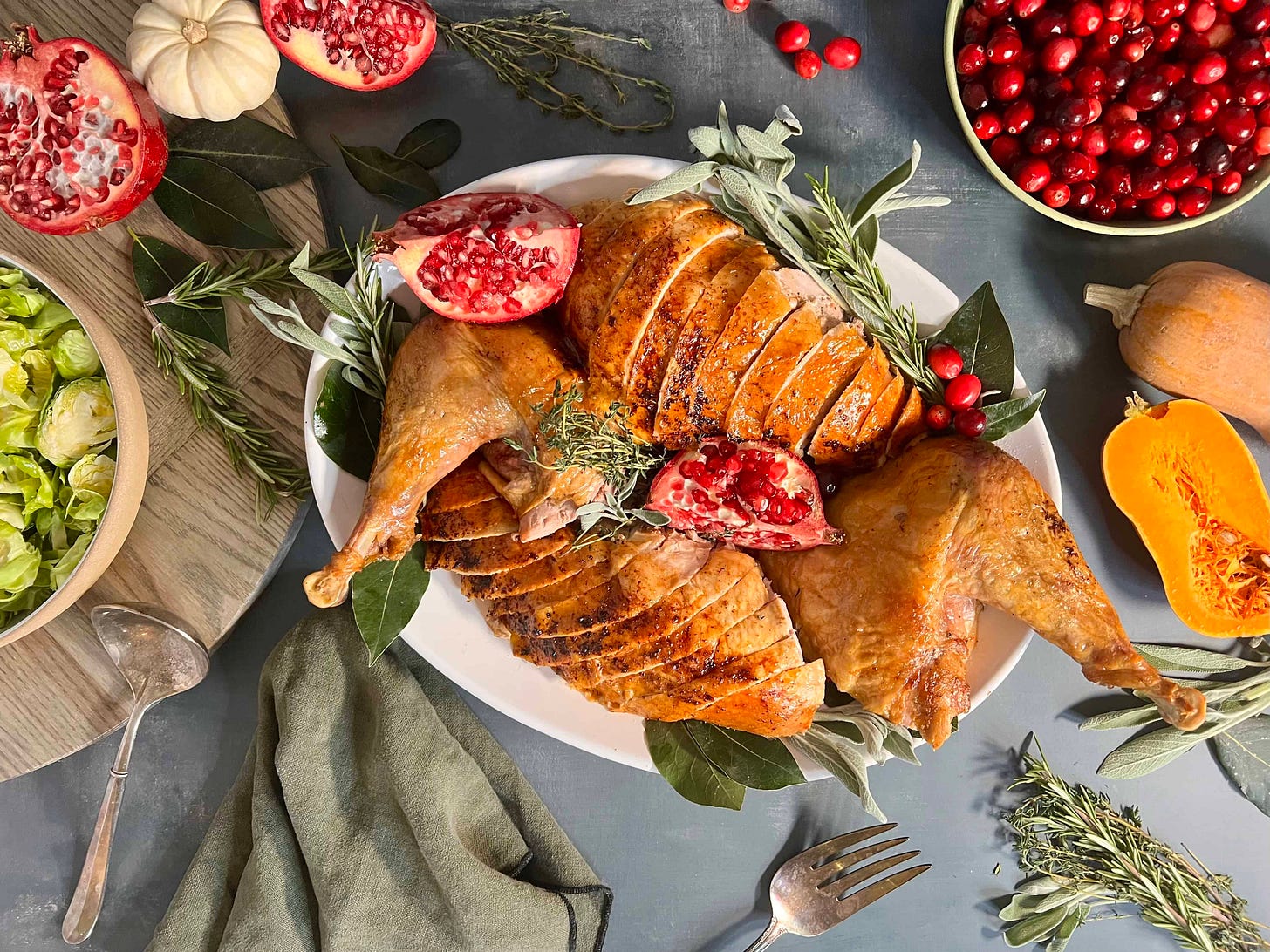We’re sure by now you’ve seen the headlines: “Turkey Shortage!” “Thanksgiving with a side of Inflation!” “Turkey prices up 24%!” While these are all technically true, most people are still going to be placing a turkey in the middle of their Thanksgiving table… So this is your BIG FAT SCREAMING NOTE to be extra proactive in your poultry procurement this year!
So this week we’re talking turkey, and giving you all the tips to put your best bird forward!
*** LIVE THANKSGIVING 911 CHAT ***
We are SO EXCITED to announce a new feature for What’s 4 Dinner?…
Elizabeth & Anthony will be standing by on Thanksgiving Day to answer ANY AND ALL of your cooking conundrums for the big day in a live chat!!
To join our chat, you’ll need to download the Substack app (messages are sent via the app, not email). Turn on push notifications so you don’t miss a chance to join conversation as it happens (and if it’s too much, you can turn off chat notifications in the “Threads” Settings).
How to get started
Download the app by clicking this link or the button below. Chat is only on iOS for now (but chat is coming to the Android app soon).
Open the app and tap the Chat icon. It looks like two bubbles in the bottom bar, and you’ll see a row for our chat inside.
That’s it! Jump into our thread to say hi, and if you have any issues, check out Substack’s FAQ.
NOW LET’S TALK TURKEY…
AU: It’s time to turn our attention to turkeys! Perhaps you’re like me? I enjoy turkey at the holidays, but it’s rarely the thing I’m most excited about on the table (it’s stuffing/dressing, btw)… But preparing a turkey mystifies many people, and so we’re going to help you take that bird from a supporting role to the headliner of your Thanksgiving spread!
I spent many Thanksgiving mornings producing live cooking segments with Sara Moulton and the inimitable/incredible Karen Pickus on Good Morning America. Together, our rag tag team covered the gamut—from gravies and sides, to pies and cranberry sauces—even cooking turkeys from start to finish live on air! So I’ve picked up a few tips along the way…
EK: And I learned all about turkey and Thanksgiving traditions in my first job, when I managed the Butterball Turkey Talk-Line! I worked with chefs, food scientists, and farmers to learn all about turkeys! I learned every possible way to roast them, from cooking bags to smokers. And, we did all kinds of consumer research to determine everyone’s favorite Thanksgiving foods and traditions. Learning everything I could about how to prep, cook and carve a turkey, and how America celebrates the holiday made me a de facto turkey expert.
DISCLAIMER:
Thanksgiving is about tradition above all things. Because of that, tensions, turkey trauma, and opinions run high regarding Thanksgiving.
We feel that the most important thing is to keep your tradition alive,
so if your “Happy Thanksgiving” relies on an injected turkey or anything else that we might not prefer, you should keep doing what makes you and your family happy for the holidays!
What turkey should I buy?
EK: Well first, let’s talk Fresh vs. Frozen. This is a big debate that my family and friends drag me into every year! I prefer a frozen turkey or a deeply chilled one like Diestel Family Ranch that is not injected or seasoned with artificial flavors. A pre-brined turkey is just fine because it will soak in a salt and sugar solution. I, personally, try to avoid birds that have been injected, as they tend to be pumped full of a very salty broth and/or vegetable oil. If you plan on brining, and your turkey is already injected, it might be too salty and the drippings will be extra salty.
AU: I’ve read that buying a frozen (or deeply chilled) turkey will ensure your cooked meat has a good texture. The theory behind this thought is that when you buy a “fresh” turkey at a grocery store, it’s often one that was frozen and then thawed at the store for purchase. Then, if you have to freeze it until Thanksgiving (and thaw again), you are creating this yo-yo effect that alters the texture of the meat. So if you buy a turkey that is frozen or deeply chilled, you have less risk of dry breast meat on your table.
EK: There are two downsides to a frozen turkey: One is that you have to plan in advance, because it can take up to five days to thaw in the refrigerator, depending on size. Two, a frozen bird loses some of its natural juices as it thaws—making brining a necessary and magical process for a juicy roasted turkey! But all in all, I still prefer a turkey that is flash frozen or deeply chilled just after it is processed.
Generally speaking…
Frozen turkeys are flash frozen the minute they are processed, so it’s basically preserved at that point.
Fresh turkey is processed around the same time as the frozen turkeys. However, fresh turkeys are held just above freezing point from the time they are processed, so they are still considered fresh. Since the turkey can travel in this state for a month or so before it is cooked, I think that a fresh turkey isn’t as pristine as the one that is flash frozen. **This generalization does not pertain to fresh turkey farms or heirloom turkeys that you may order and/or pick up when the turkey is processed.**
AU: And while we’re here, let’s just settle this debate once and for all: SIZE MATTERS. If you have a huge crowd to feed, I do not recommend buying a 24 lbs bird. Why? Those massive birds are cumbersome to wrangle, they’re tricky to cook properly (just because of a turkey’s natural geometry), and they take forever! Instead, I would buy TWO 12 lbs. birds to cook. Or a 14-lb turkey and an additional bone-in breast to feed everyone. Smaller birds are easier to prepare and cook.
EK: I couldn’t agree with you more. And, if your crowd loves white meat, consider roasting one whole turkey and one turkey breast. Purchase 1-2 pounds of turkey per person at your table, in order to feed the crowd and have some for leftovers.
What do I do if my turkey is still frozen?
EK: If you are buying a frozen turkey, you should buy your turkey the weekend before Thanksgiving—or in the case of this year, even sooner. Anthony and I both cooked Diestel Family Ranch Turkeys and they recommend ordering from their website by November 17.
To thaw, place the turkey on a tray in the fridge in its original wrapping and let it slowly thaw during the days leading up to Thanksgiving.
AU: The general rule for defrosting a turkey in the fridge is 24 hrs for every 4 pounds of bird. So if you’re cooking a 12 lbs. turkey, you need to thaw it in the refrigerator for three solid days.
EK: If it is still frozen on Thanksgiving morning, place it in a large clean sink under cold running water for 2-4 hours depending how frozen it is; if it’s solid frozen it could take longer. Do not use hot water, you’ll create the perfect temperature for bacteria to grow and may have a food safety issue on your hands.
How do I guarantee my turkey will be juicy?
EK: Brining is an absolutely no-fail guarantee for a perfectly seasoned and juicy turkey. And, brining has an added bonus: it ensures that your turkey is thawed!
AU: Okay… here’s where EK and I have different opinions. I don’t like to brine, because when I have in the past, the turkey meat ends up spongey and weird.
EK: That sounds like you over-brined your bird. You only want to brine a turkey that has not been pre-seasoned (by the processor) and I recommend brining the turkey overnight and no longer than 24 hours. Anthony, I bet you brined a bird that had already been injected. Try brining your turkey at home with a simple basic brine like below, or a flavor brine, such as my orange brine.
What is a Brine?
Originally, a brine was a strong salt-water solution used for preserving meat. Today, cooks use a salt-and-sugar-water solution to enhance the flavor of lean meat. A “flavor brine” adds spices, fruits, juices and other ingredients to the basic brine formula.
How do you Brine?
Think of a brine as a simple marinade. Brining is simply submerging the meat into the salt-and-sugar-water solution and letting it “soak” for up to 24 hours for a turkey and as short as 1 hour for small cuts of poultry, pork or fish.
To do this, you may want to seek out a heavy duty “brining bag” or use a large container that fits in your refrigerator, or even a dedicated, hard-sided cooler.
BASIC BRINE
This recipe can be multiplied to accommodate larger pieces of meat.
Makes about 1 Gallon
1 cup kosher salt
1 cup brown sugar or sweetener such as honey or maple syrup
4 quarts cold water, divided
Boil 2 quarts of water, add sugar and salt, stirring until completely dissolved.
Add rest of water and let cool.You can add ice cubes to the boiled salt/sugar solution to cool the brine down faster.
It’s optimal to brine the turkey in fridge or in a cooler outside (depending on the outside temperature). Brine the turkey overnight and never longer than 24 hours. If your turkey is 10-15 pounds, only brine it 12 hours. The smaller the turkey, the less time it needs and vice versa. It will be completely seasoned inside and out and will require very little else to get it ready for the oven or the grill.
What is a Dry Brine?
AU: Dry brining is my preferred method, and it basically works the same way a wet brine works. The downside of Dry Brining is that you need the refrigerator space to let the bird sit uncovered in the fridge for a day. Wet Brine advocates also argue that the salt never truly penetrates the skin, and therefore doesn’t do much for the turkey meat itself.
EK:I love a dry brine and have done it many times with a chicken but never with a turkey. I disagree with the haters and feel certain that the salt will combine with the turkey juices and be absorbed by the meat—just at a slower rate. If I had an extra refrigerator, I would totally try it out!
BASIC DRY BRINE
To Dry Brine your bird, use 2 teaspoons of Diamond Crystal Kosher salt per pound (if using Morton’s Kosher Salt, scale down to 1 teaspoon per pound). Then you can add in some white or brown sugar, which will help with browning and add a pleasant sweetness to the meat. One quarter the amount of salt you used should do the trick. To that you can add all kinds of aromatics, herbs, spices, citrus zest, pepper, etc., as desired.
Basic Dry Brine for 12 pound Turkey
24 teaspoons (1/2 cup) Diamond Crystal Kosher Salt
6 teaspoons (2 tablespoons) white or brown sugar
In a small bowl, combine salt and sugar until well mixed. Stir in any other aromatics, spices, or herbs, if desired. Set turkey on a rack in a rimmed baking sheet (or whatever you’re using to cook the bird), and refrigerate uncovered for 12-24 hours. Do not rinse before cooking.
Next week we’re talking more turkey! Find out how to cook and carve the bird with zero stress! Plus, we are giving you a make-ahead gravy that will be your new Thanksgiving MVP!









